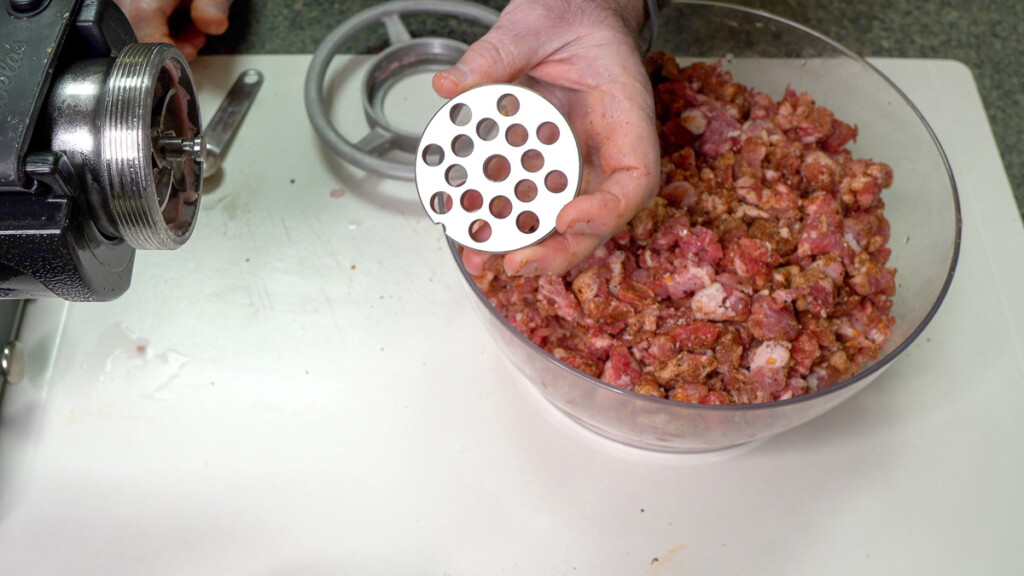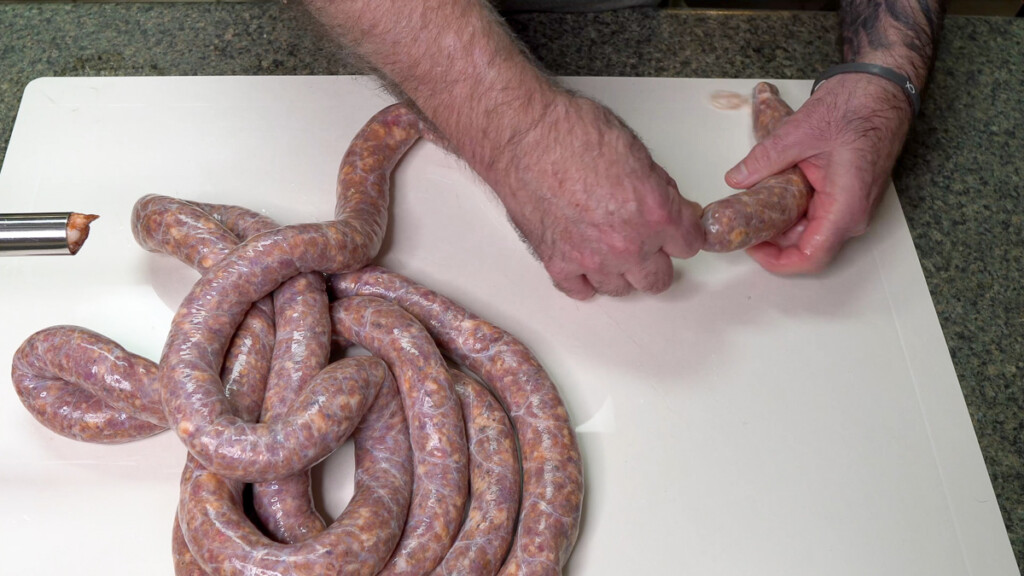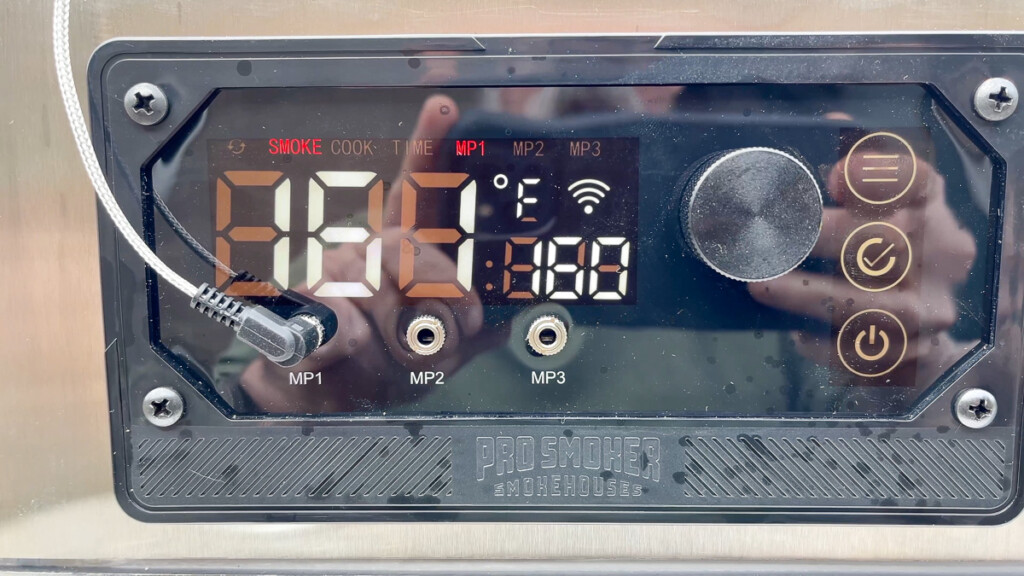Sausage making takes a bit of time, but the flavor-packed reward is always worth it with these smoked Texas Hot Links.
Also known as Texas hot guts, these spicy, heavily seasoned cured sausages are a staple at most Hill Country BBQ restaurants.
Find step-by-step instructions below, or head to the video to see just how ridiculously juicy these sausages are.
Smoked Texas hot links
You will need extra equipment to make sausage at home, like a meat grinder and a sausage stuffer. But rest assured, homemade sausages aren’t difficult to make. You just have to set aside time to complete each step, as there are some extended waiting periods.
If you want some extra tips and tricks, here are our comprehensive guides to making and smoking sausage at home.
Ingredients you’ll need
- Natural hog casings
- Pork – either pork trimmings or pork butt, partially frozen.
- Beef chuck roast – brisket trimmings are also popular in Texas. Partially frozen.
- Cure – Insta Cure #1 is a go-to.
- Non-fat dry milk powder
- Seasonings – paprika, mustard powder, chili powder, red pepper flakes, Kosher salt, coarse ground black pepper, garlic powder, onion powder, and sugar.
Equipment you’ll need
What are Texas hot links?
Texas hot links are a type of spicy, smoked sausage typically made with beef or a beef and pork blend.
We use red pepper flakes, paprika, and chili powder to bring the heat. Other spices like garlic powder, mustard powder, and onion powder ensure each sausage is packed with flavor.
You’ll find that East Texas hot links are baked rather than smoked, but we’re sticking with tradition today.
Some recipes also include venison, but if I were you, I’d use that cut for these smoked venison snack sticks instead.
What is the best wood for smoking hot links?
Hickory is the most popular wood choice for Texas hot links. I’m using a combination of cherry and hickory.
My top sausage making tip
Before we dive into the instructions, there’s one thing you must know to make the best sausage at home: Keep your meat and equipment as cold as possible.
I highly recommend storing your meat in the freezer between each step to ensure it’s sitting just below frozen (around 35°F) when you grind it. You can also place the grinder head in the freezer beforehand. Trust me, it makes a massive difference in sausage quality.
How to make smoked Texas hot links step-by-step instructions
1. Prep the casings
First, you must prep the natural hog casings to make them as pliable as possible.
Rinse them under running water to remove the salt, then soak them in warm water for an hour. Repeat this step for another hour.
Alternatively, rinse them and soak them overnight in water and half a teaspoon of baking soda in the fridge.
2. First grind
Cut your partially frozen beef and pork into cubes that fit down your grinder’s throat.
Start with a kidney grinder plate for a coarse ground sausage.
Grind your meat cubes, then place the ground meat back in the freezer until you are ready to mix in the spice mix.
3. Mix the ground meat
Measure out the spices and mix them together.
Remove the ground meat from the freezer and put it into a bowl. Sprinkle the spice mix over the top and hand-mix the seasoning into the ground meat.
Pop the meat back in the freezer while you change the meat grinder plate.
4. Second grind
Place a 10mm plate on your meat grinder.

Remove the meat from the freezer and grind for the second time.
5. Add-ins
Next, sprinkle the milk powder over the ground meat. It acts as a binder and helps the meat retain moisture so you produce the juiciest sausages possible.
Then, mix the cure and water together and add this to the ground meat.
Hand-mix the meat again until you start getting protein extraction.
The easiest way to determine this is to grab a bit of meat in your hand. If it sticks when you turn your hand upside down, you can move on to the next step.
6. Stuff the sausage
Place the ground meat in the sausage stuffer. Pack it tightly to remove as much air as possible.
Wet the horn and thread on the moist casings.
When you get to the end of the casing, tie a knot in it.
Once my casing is all on the horn and the the knot is tied, I like to poke a few holes in the end to let out any air.
Begin stuffing the casing with the sausage mixture.
When you get to the end of your stuffing, cut the casing, giving yourself a bit of length, and tie a knot in the end as close to the meat as possible.
To make the individual sausages, you want to twist the casing. I’m not measuring, but if you were to measure, you’d want each sausage to be about 8-10″.

Once complete, grab your sausage pricker to remove any visible air pockets trapped between the casing and the meat.
Don’t skip this step; it ensures the sausage properly binds to the casing.
7. Dry out the sausage
Place the fresh sausage links in the fridge overnight to dry them out and activate the cure.
This process will take between 12 to 24 hours.
Unless you use a cure accelerator, you don’t want to smoke the sausage on the same day.
8. Smoke the sausage
24 hours later, loop the sausages onto rods and place them in your vertical smoker. Then, set your smoker to 110°F to start your 1-1½ hour drying cycle to warm up the sausage.
Ensure the smoker’s top and bottom vents are open.
Once the drying cycle is complete, add the sawdust pan to the bottom of your vertical smoker. I used a 50/50 split of cherry and hickory sawdust.
At the same time, decrease the bottom vent to a quarter open and keep the top about halfway open.
Set the smoker to 135°F and let the sausages smoke for two hours.
After two hours, increase the temperature to 145°F, and smoke the sausages for another two hours.
After two hours, increase the temperature to 160°F, and smoke the sausages for one hour.

After one hour, push the temperature up to 180°F until the sausages reach an internal temperature of 155°F.
9. Cool the sausage
Once they hit 155°F, plunge the smoked sausage links immediately into an ice bath and let them cool down until they reach an internal temperature of around 100°F.
The ice bath stops the sausages from continuing to cook and prevents them from shriveling.
10. Let the sausage bloom
Place the sausages on a wire rack on a baking sheet and let them sit at room temperature for about two hours to bloom. Blooming gives them an even richer color.
11. Taste-test the sausage
The final step is to place them in a ziplock bag in the fridge overnight.
Have a taste test of your juicy Texas hot links the following day, and prepare to be wowed.
Store the remaining sausage properly sealed in the fridge for up to three weeks or in the freezer for up to six months. I like to reheat them in the oven before serving.
What to eat with Texas hot links?
A common way to serve hot guts in Texas is with sliced white bread (Texas toast if you have some handy), pickles, and onion slices. For condiments, stick to the classics like ketchup, BBQ sauce, hot sauce, or mustard.
It’s also popular in a Texas barbecue spread alongside brisket, coleslaw, and potato salad.
More sausage recipes
Now you have the equipment, check out these other smoked sausage recipes:
Smoked Texas Hot Links Recipe
Print
Smoked Texas Hot Links
Spicy, flavor-packed beef and pork cured sausages.
Course Main Course
Cuisine American
Cook Time 8 hours hours
Drying out 2 days days
Total Time 2 days days 8 hours hours
Servings 14 sausages
Calories 307kcal
Author Russ Jones
- 2.5 lbs pork butt
- 2.5 lbs beef chuck roast or brisket
- 5.67 g (0.25%) Insta Cure #1
- 226.8 g (10%) water
- 1 cup non-fat dry milk powder
Seasoning – based on % of total meat weight
- 9.07 g (0.4%) paprika
- 9.07 g (0.4%) mustard powder
- 6.35 g red pepper flakes
- 4.53 g chili powder (regular, chipotle, or cayenne pepper)
- 34.2 g (1.5%) Kosher salt
- 22.68 g (1%) coarse ground black pepper
- 20.41 g (0.9%) garlic powder
- 15.87 g (0.7%) onion powder
- 11.34 g (0.5%) sugar
Rinse the casings to remove the salt, then soak them in warm water for an hour. Repeat this step for another hour. Alternatively, rinse them and soak them overnight in water and half a teaspoon of baking soda in the fridge.
Cut the partially frozen beef and pork into cubes that fit down your grinder’s throat. Coarse-grind the sausage using a kidney grinder plate, then return the ground meat to the freezer.
Measure out the spices and mix them together, then hand-mix the seasoning into the ground meat.
Place a 10mm plate on your meat grinder and grind the meat again.
Hand-mix the milk powder into the ground meat, then mix the cure and water together and add this. Hand-mix until you start getting protein extraction.
Place the ground meat in the sausage stuffer, packing it tightly to remove air. Wet the horn, thread on the moist casings, then stuff the sausage.
Twist the stuffed sausage to make individual sausage links about 8-10" each. With the sausage pricker, remove any visible air pockets.
Place the sausage links in the fridge for 12 to 24 hours to dry them out and activate the cure.
Loop the sausages on rods and place them in your vertical smoker. Set it to 110℉ to start your 1-1½ hours drying cycle. Ensure the top and bottom vents are open.
Once complete, add the sawdust pan to the smoker's bottom, decrease the bottom vent to a quarter open, and keep the top about halfway open.
Set the smoker to 135°F for two hours, increase to 145°F for two hours, increase to 160°F for one hour, then push it up to 180°F until the sausages reach an internal temperature of 155°F.
Plunge the cooked sausages immediately in an ice bath and let them cool down until they reach an internal temperature of around 100℉.
Place the sausages on a wire rack on a baking sheet and let them sit at room temperature for about two hours to bloom.
Place them in a ziplock bag in the fridge overnight and serve the next day.
A note on using grams and percentages
While the vast majority of our recipes use imperial measurements, using grams and percentages in sausage making is crucial for accuracy, consistency, and control over the final product.
It makes it easy to scale and adjust recipes, and is important when working with cure. I highly recommend investing in a cheap digital scale that can switch between different units.Calories: 307kcal | Carbohydrates: 9g | Protein: 35g | Fat: 14g | Saturated Fat: 6g | Polyunsaturated Fat: 1g | Monounsaturated Fat: 7g | Trans Fat: 1g | Cholesterol: 106mg | Sodium: 1126mg | Potassium: 782mg | Fiber: 1g | Sugar: 6g | Vitamin A: 756IU | Vitamin C: 1mg | Calcium: 152mg | Iron: 3mg
Did you miss our previous article...
https://manstuffnews.com/backyard-grilling/stoke-vs-ooni-which-pizza-oven-is-better
 Backyard GrillingWeekend WarriorsAdvice from DadBeard GroomingTV Shows for Guys4x4 Off-Road CarsMens FashionSports NewsAncient Archeology World NewsPrivacy PolicyTerms And Conditions
Backyard GrillingWeekend WarriorsAdvice from DadBeard GroomingTV Shows for Guys4x4 Off-Road CarsMens FashionSports NewsAncient Archeology World NewsPrivacy PolicyTerms And Conditions
